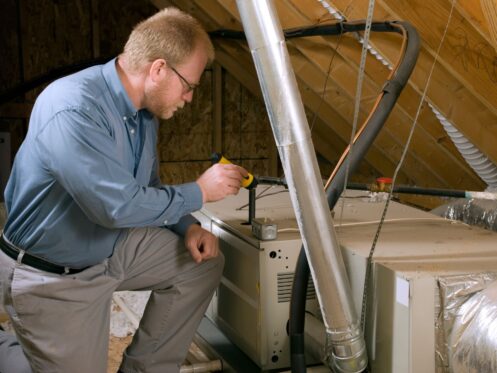A well-functioning furnace is essential for keeping your home warm and comfortable during the cold months. However, like any other machine, furnaces can develop problems over time. Understanding the common issues that furnaces face and how to troubleshoot them can help you maintain a comfortable home environment.
Common Furnace Problems Homeowners Face
Furnaces, like all mechanical systems, can develop a range of issues over time. One common problem is the furnace not producing enough heat. This can be caused by a dirty filter, a malfunctioning thermostat, or an issue with the pilot light. Another frequent issue is the furnace cycling on and off too frequently, often due to a clogged filter or improper thermostat settings.
Another problem homeowners often encounter is strange noises coming from the furnace. Rattling, banging, or squealing sounds can indicate loose components, worn belts, or motor issues. Ignoring these noises can lead to more serious problems down the line. Additionally, some furnaces may experience ignition problems, where the furnace fails to light up properly. This can result from a faulty ignition system or pilot light issues.
Poor airflow is another common issue, and it can severely impact the efficiency of your heating system. This problem is often caused by blocked or dirty air ducts, which restrict the flow of warm air throughout your home. Regular maintenance, including air duct cleaning, can help alleviate this problem.
Identifying Furnace Issues by Signs and Symptoms
Identifying furnace issues early can save you from more extensive repairs later. One sign of a problem is if your energy bills suddenly increase without a change in usage. This often indicates that your furnace is working harder than it should be, possibly due to a mechanical issue or poor airflow.
Unusual noises are another clear sign that something is wrong. Rattling sounds may suggest loose parts, while a squealing noise can indicate a problem with the blower motor or belt. Ignoring these sounds can result in more severe damage over time.
A furnace that doesn’t produce enough heat or fails to turn on entirely is also a significant red flag. This could be caused by a malfunctioning thermostat, ignition problems, or issues with the gas supply. Finally, frequent cycling on and off can indicate an issue with the thermostat settings or a clogged filter. Recognizing these signs early allows for timely furnace repair, ensuring your home stays warm and comfortable.
DIY Troubleshooting Tips for Minor Furnace Problems
Many minor furnace issues can be resolved with some basic troubleshooting steps. Start by checking the thermostat settings. Ensure it is set to “heat” and that the temperature setting is higher than the current room temperature. Sometimes, the problem can be as simple as a thermostat set incorrectly.
Next, examine your furnace filter. A dirty or clogged filter can restrict airflow, causing the furnace to work harder. Replace or clean the filter if it appears dirty. Filters should be checked and replaced regularly to maintain system efficiency.
Check the power supply to the furnace. Ensure the furnace switch is turned on and verify that the circuit breaker has not tripped. If the breaker has tripped, reset it and see if the furnace starts functioning correctly. If it trips again, you may need to call a professional for furnace repair to address a possible electrical issue.
If the pilot light is out, relight it following the manufacturer’s instructions. Be cautious and make sure to turn off the gas supply before attempting to relight the pilot. Always follow safety protocols to prevent accidents.
When to Call Professionals for Furnace Repair
While many minor issues can be addressed with simple troubleshooting, some problems require the expertise of our professionals. If your furnace is making loud or unusual noises that persist after basic checks, it’s time to call in the experts. These sounds could indicate more severe mechanical issues that need professional attention.
If you smell gas, evacuate your home immediately and contact emergency services. A gas leak is a severe hazard that requires immediate professional intervention. Do not attempt to fix this issue on your own.
Inconsistent heating or a furnace that doesn’t respond to thermostat adjustments often signal more complex problems. These can include malfunctioning sensors, electrical issues, or failing components that require specialized tools and knowledge to diagnose and repair.
Another indicator that you need professional help is if your furnace has difficulty turning on or frequently cycles on and off. These issues can stem from problems with the ignition system, sensors, or electrical connections. Our technicians can accurately diagnose and fix these issues to restore your furnace’s optimal performance.
Conclusion
Addressing furnace repair issues promptly is crucial for maintaining a warm and comfortable home. Understanding common problems, identifying signs and symptoms, and knowing when to call in our professionals can save you time and money. Basic troubleshooting can resolve minor issues, but some problems require the expertise of skilled technicians.
A well-maintained furnace ensures efficient operation and a longer lifespan for your heating system. By staying vigilant and addressing issues early, you can keep your furnace running smoothly. Remember that safety is paramount, and if you are ever unsure, it is best to consult with professionals.
For expert furnace repair in Derby, trust Midwest Mechanical. Our professionals are ready to help you with all your heating needs. Contact us today to schedule an appointment and ensure your furnace is in top condition.
